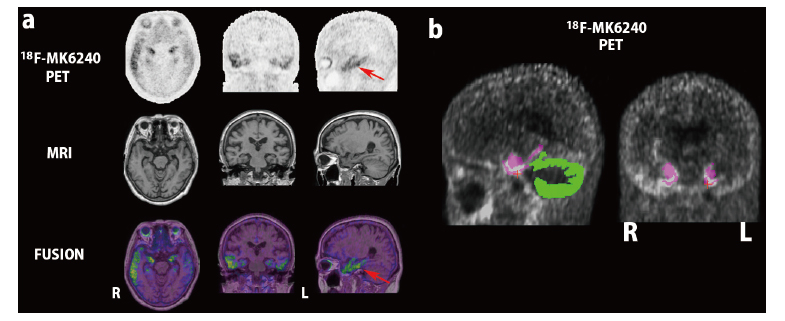Alzheimer’s disease (AD) is diagnosed by the presence of both amyloid β and tau proteins. Recent advances in molecular PET imaging have made it possible to assess the accumulation of these proteins in the living brain. PET ligands have been developed that bind to 3R/4R tau in AD, but not to 3R tau or 4R tau alone. Of the first-generation PET ligands, 18F-flortaucipir has recently been approved by the Food and Drug Administration. Several second-generation PET probes with less off-target binding have been developed and are being applied clinically. Visual interpretation of tau PET should be based on neuropathological neurofibrillary tangle staging instead of a simple positive or negative classification. Four visual read classifications have been proposed: “no uptake,” “medial temporal lobe (MTL) only,” “MTL AND,” and “outside MTL.” As an adjunct to visual interpretation, quantitative analysis has been proposed using MRI-based native space FreeSurfer parcellations. The standardized uptake value ratio of the target area is measured using the cerebellar gray matter as a reference region. In the near future, the Centiloid scale of tau PET is expected to be used as a harmonized value for standardizing each analytical method or PET ligand used, similar to amyloid PET.
Abstract/References
Tau positron emission tomography in patients with cognitive impairment and suspected Alzheimer’s disease
Hiroshi Matsuda, Tensho Yamao
-
Hiroshi Matsuda
Department of Biofunctional Imaging, Fukushima Medical University
-
Tensho Yamao
Department of Radiological Sciences, School of Health Sciences, Fukushima Medical University
Abstract
References
7. Rabinovici GD, Gatsonis C, Apgar C, et al. Association of amyloid positron emission tomography with subsequent change in clinical management among Medicare beneficiaries with mild cognitive impairment or dementia. JAMA, 321:1286-1294, 2019.
11. Cassinelli Petersen G, Roytman M, Chiang GC, Li Y, Gordon ML, Franceschi AM. Overview of tau PET molecular imaging. Curr Opin Neurol, 35:230-239, 2022.
12. Wang Y, Mandelkow E. Tau in physiology and pathology. Nat Rev Neurosci, 17:5-21, 2016.
20. Marquié M, Normandin MD, Vanderburg CR, et al. Validating novel tau positron emission tomography tracer [F-18]-AV-1451 (T807) on postmortem brain tissue. Ann Neurol, 78:787-800, 2015.
21. Mattay VS, Fotenos AF, Ganley CJ, Marzella L. Brain tau Imaging:Food and Drug Administration approval of 18F-Flortaucipir Injection. J Nucl Med, 61:1411-1412, 2020.
23. Sander K, Lashley T, Gami P, et al. Characterization of tau positron emission tomography tracer [18F]AV-1451 binding to postmortem tissue in Alzheimer’s disease, primary tauopathies, and other dementias. Alzheimers Dement, 12:1116-1124, 2016.
24. Lowe VJ, Curran G, Fang P, et al. An autoradiographic evaluation of AV-1451 Tau PET in dementia. Acta Neuropathol Commun, 4:58, 2016.
26. Lee CM, Jacobs HIL, Marquié M, et al. 18F-Flortaucipir Binding in Choroid Plexus:Related to Race and Hippocampus Signal. J Alzheimers Dis, 62:1691-1702, 2018.
27. Ikonomovic MD, Uryu K, Abrahamson EE, et al. Alzheimer’s pathology in human temporal cortex surgically excised after severe brain injury. Exp Neurol, 190:192-203, 2004.
28. Choi JY, Cho H, Ahn SJ, et al. Off-Target 18F-AV-1451 Binding in the Basal Ganglia Correlates with Age-Related Iron Accumulation. J Nucl Med, 59:117-120, 2018.
29. Ikonomovic MD, Abrahamson EE, Price JC, Mathis CA, Klunk WE. [F-18]AV-1451 positron emission tomography retention in choroid plexus: More than “off-target” binding. Ann Neurol, 80:307-308, 2016.
31. Hansen AK, Brooks DJ, Borghammer P. MAO-B Inhibitors do not block in vivo Flortaucipir([18F]-AV-1451) binding. Mol Imaging Biol, 20:356-360, 2018.
32. Yap SY, Frias B, Wren MC, et al. Discriminatory ability of next-generation tau PET tracers for Alzheimer’s disease. Brain, 144:2284-2290, 2021.
33. Honer M, Gobbi L, Knust H, et al. Preclinical Evaluation of 18F-RO6958948, 11C-RO6931643, and 11C-RO6924963 as Novel PET Radiotracers for Imaging Tau Aggregates in Alzheimer Disease. J Nucl Med, 59:675-681, 2018.
34. Wong DF, Comley RA, Kuwabara H, et al. Characterization of 3 Novel Tau Radiopharmaceuticals, 11C-RO-963, 11C-RO-643, and 18F-RO-948, in Healthy Controls and in Alzheimer Subjects. J Nucl Med, 59:1869-1876, 2018.
35. Kuwabara H, Comley RA, Borroni E, et al. Evaluation of 18F-RO-948 PET for Quantitative Assessment of Tau Accumulation in the Human Brain. J Nucl Med, 59:1877-1884, 2018.
37. Blennow K, Chen C, Cicognola C, et al. Cerebrospinal fluid tau fragment correlates with tau PET:a candidate biomarker for tangle pathology. Brain, 143:650-660, 2020.
50. Hostetler ED, Walji AM, Zeng Z, et al. Preclinical characterization of 18F-MK-6240, a promising PET tracer for In vivo quantification of human neurofibrillary tangles. J Nucl Med, 57:1599-1606, 2016.
52. Betthauser TJ, Cody KA, Zammit MD, et al. In vivo characterization and quantification of neurofibrillary tau PET radioligand 18F-MK-6240 in humans from Alzheimer disease dementia to young controls. J Nucl Med, 60:93-99, 2019.
53. Lohith TG, Bennacef I, Vandenberghe R, et al. Brain imaging of Alzheimer dementia patients and elderly controls with 18F-MK-6240, a PET tracer targeting neurofibrillary tangles. J Nucl Med, 60:107-114, 2019.
54. Pascoal TA, Therriault J, Benedet AL, et al. 18F-MK-6240 PET for early and late detection of neurofibrillary tangles. Brain, 143:2818-2830, 2020.
55. Aguero C, Dhaynaut M, Normandin MD, et al. Autoradiography validation of novel tau PET tracer [F-18]-MK-6240 on human postmortem brain tissue. Acta Neuropathol Commun, 7:37, 2019.
57. Braak H, Braak E. Neuropathological stageing of Alzheimer-related changes. Acta Neuropathol, 82:239-259, 1991.
59. Gogola A, Minhas DS, Villemagne VL, et al. Direct Comparison of the Tau PET Tracers 18F-Flortaucipir and 18F-MK-6240 in Human Subjects. J Nucl Med, 63:108-116, 2022.
62. Vogel JW, Iturria-Medina Y, Strandberg OT, et al. Spread of pathological tau proteins through communicating neurons in human Alzheimer’s disease. Nat Commun, 11:2612, 2020.
65. Krishnadas N, Huang K, Schultz SA, et al. Visually Identified Tau 18F-MK6240 PET Patterns in Symptomatic Alzheimer’s Disease. J Alzheimers Dis, 88:1627-1637, 2022.
66. Villemagne VL, Doré V, Bourgeat P, et al. The Tau MeTeR composites for the generation of continuous and categorical measures of tau deposits in the brain. J Mol Med Ther, 1:25-32, 2017.
Figures

